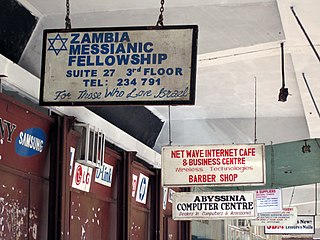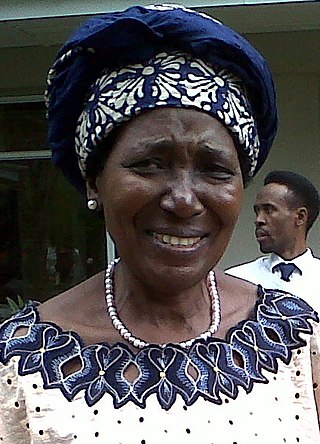Related Research Articles

Zambia, officially the Republic of Zambia, is a landlocked country at the crossroads of Central, Southern and East Africa. It is typically referred to being in South-Central Africa or Southern Africa. It is bordered to the north by the Democratic Republic of the Congo, Tanzania to the north-east, Malawi to the east, Mozambique to the southeast, Zimbabwe and Botswana to the south, Namibia to the southwest, and Angola to the west. The capital city of Zambia is Lusaka, located in the south-central part of Zambia. The population is concentrated mainly around Lusaka in the south and the Copperbelt Province to the north, the core economic hubs of the country.

The University of Zambia (UNZA) is a public university located in Lusaka, Zambia. It is Zambia's largest and oldest learning institution. The university was established in 1965 and officially opened to the public on 12 July 1966. The language of instruction is English.
The Zambian National Women's Lobby is a Zambian organization whose mission is to "bridge the gender gap in political decision making by advocating for increased women's participation and representation". The Lobby was created following Zambia's transition from a one-party state to a multi-party democracy in 1990. At the time, only seven women served in the Parliament of Zambia out of 150 seats, and only three women served on the Central Committee, the equivalent of today's Presidential Cabinet. The official motto of ZNWL is "WIZER" which stands for "Women in Zambia for Equality Representation".

Zambia has several major indigenous languages, all members of the Bantu family, as well as Khwedam, Zambian Sign Language, several immigrant languages and the pidgins Settla and Fanagalo. English is the official language and the major language of business and education.

Lesbian, gay, bisexual, transgender, and queer (LGBTQ) people in Zambia face significant challenges not experienced by non-LGBTQ residents. Same-sex sexual activity is illegal for both men and women in Zambia. Formerly a colony of the British Empire, Zambia inherited the laws and legal system of its colonial occupiers upon independence in 1964. Laws concerning homosexuality have largely remained unchanged since then, and homosexuality is covered by sodomy laws that also proscribe bestiality. Social attitudes toward LGBTQ people are mostly negative and coloured by perceptions that homosexuality is immoral and a form of insanity. However, in recent years, younger generations are beginning to show positive and open minded attitudes towards their LGBTQ peers.
HIV/AIDS is considered the deadliest epidemic in the 21st century. It is transmitted through sex, intravenous drug use and mother-to-child transmission. Zambia is experiencing a generalized HIV/AIDS epidemic, with a national HIV prevalence rate of 11.3% among adults ages 15 to 49 as of 2018. Per the 2000 Zambian census, the people affected by HIV/AIDS constituted 15% of the total population, amounting to one million, of which 60% were women. The pandemic results in increased number of orphans, with an estimated 600,000 orphans in the country. It was prevalent more in urban areas compared to rural and among all provinces, Copperbelt Province and Lusaka Province had higher occurrence.
The 2000 Zambian census was conducted in Zambia in 2000 by DRS under approval of the Government of Zambia, which recorded demographic data from 13 million people and 4 million households. Planning for the project commenced in 1998. In October 2000 the census started, with more than 30,000 workers across Zambia completing the 17 million double-sided A4 forms. The census was completed in May 2001. The scanning was undertaken in collaboration with the Examinations Council of Zambia (ECZ) and published by the Central Statistical Office. The census was noted by the Milton Keynes & North Bucks Chamber of Commerce and the DRS received a special commendation for its census work in Africa.

Chilanga is a township located 20 km south of Zambia's capital city, Lusaka. It is situated midway between Lusaka and Kafue on the T2 road.

Lusaka is the capital and largest city of Zambia. It is one of the fastest-developing cities in southern Africa. Lusaka is in the southern part of the central plateau at an elevation of about 1,279 metres (4,196 ft). As of 2019, the city's population was about 3.3 million, while the urban population is estimated at 2.5 million in 2018. Lusaka is the centre of both commerce and government in Zambia and connects to the country's four main highways heading north, south, east, and west. English is the official language of the city administration, while Bemba and Nyanja are the commonly-spoken street languages.

Kabwe District is a district of Zambia, located in Central Province. The capital lies at Kabwe. As of the 2010 Zambian Census, the district had a population of 299,206 people. It consists of two constituencies, namely Kabwe Central and Bwacha.

Chingola District is a district of Zambia, located in Copperbelt Province. The capital lies at Chingola. As of the 2022 Zambian Census, the district had a population of 299,936 people. It is divided into two constituencies, namely Chingola constituency and Nchanga constituency.

First Lady of Zambia is the title attributed to the wife of the president of Zambia. Zambia's current first lady is Mutinta Hichilema, who has held the office since 24 August 2021.

Inonge Mutukwa Wina is a Zambian politician who served as the 13th Vice President from 2015 to 2021. She was the first woman to hold the position, which made her the highest ranking woman in the history of the Zambian government.

Mafinga District is one of the eight districts of Muchinga Province in Zambia. The district headquarters is at Thendere. It also contains the town of Muyombe. It was named after the Mafinga Hills. As of the 2022 Zambian Census, the district had a population of 102,533 people. Chitumbuka, also known as Tumbuka, is the dominant primary language spoken in the district.

A komboni is a type of informal housing compound or shanty town common to Zambia, particularly the capital city of Lusaka. It is characterized by a low income and a high population density. Kombonis typically began as housing for employees of a particular company, estate, or mine. An estimated 35% of Zambians live in urban areas, and kombonis exist in many of them. It is estimated that 80% of the population of Lusaka live and work in these areas.

Nkandu Phoebe Luo is a Zambian microbiologist and politician who was a vice presidential candidate for the Patriotic Front in the August 2021 election. She is a microbiologist who previously served as Head of Pathology and Microbiology at the University Teaching Hospital in Lusaka and has carried out extensive research into HIV/AIDS.

Lunga District is a district in the Luapula Province of Zambia. It was declared a district in 2012 by Michael Sata. The district comprises archipelago of islands in the Bangweulu Wetlands in the south-east of Lake Bangweulu. As of the 2022 Zambian Census, the district had a population of 39,383 people.

Racheal Kundananji is a Zambian professional footballer who plays as a forward for National Women's Soccer League club Bay FC and the Zambia national team.

Chikankata District is a district of Southern Province, Zambia. It was separated from Mazabuka District in December 2011. As of the 2022 Zambian Census, the district had a population of 98,671 people.

The status of women in Zambia has improved in recent years. Among other things, the maternal mortality rate has dropped and the National Assembly of Zambia has enacted multiple policies aimed at decreasing violence against women. However, progress is still needed. Most women have limited access to reproductive healthcare, and the total number of women infected with HIV in the country continues to rise. Moreover, violence against women in Zambia remains common. Child marriage rates in Zambia are some of the highest in the world, and women continue to experience high levels of physical and sexual violence.
References
- ↑ Hansen, Karen Tranberg (1996). "Gender, Generation, and Access to Housing in Zambia". In Schlyter, Ann (ed.). A Place to Live: Gender Research on Housing in Africa. Nordic Africa Institute. pp. 127–44. ISBN 9789171063885.